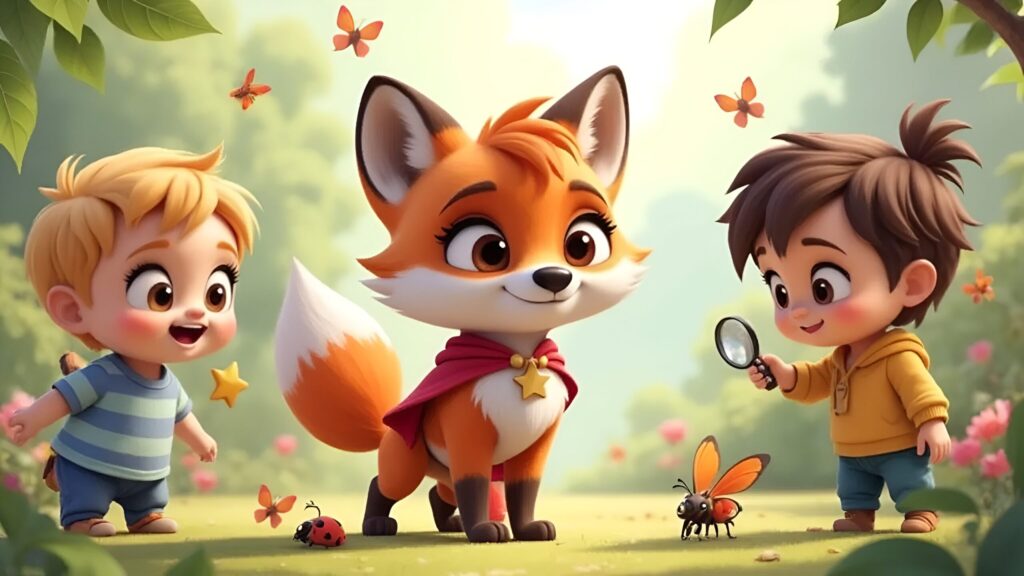Are you worried that your child’s fear of insects is holding them back from fully experiencing the wonders of outdoor play? Perhaps you’ve noticed that even the sight of a tiny beetle triggers anxious reactions, or maybe you want to nurture your little one’s curiosity about nature before their fear of bugs grows into a permanent phobia. If you’ve been searching for practical, real-world solutions to help your child conquer entomophobia, you’re in the right place.
In this guide, we’ll explore how to address the root causes of bug anxiety, discover how simple exposure strategies can help transform fear into fascination, and learn about child-friendly tools — including the Lunesia app — that empower kids to embrace all the buzzing, crawling life in their backyard. From mindful breathing techniques to step-by-step methods of safe bug encounters, every strategy is based on real-life experiences and expert insights. Whether your child is afraid of bees, wasps, spiders, or any bug in between, get ready to boost their confidence and rekindle their love for nature!
Ready to say bye-bye to bug-based tantrums and hello to backyard adventures? Keep reading, because you’re about to unlock the secrets to fear-free exploration.
A Simple Realization that Changed My Perspective
I remember the day my niece threw her sandwich in the air and ran shrieking from a picnic table, convinced that a single hovering bee spelled disaster. Watching her panic, I realized how easily a child’s fear of insects can stop them from enjoying the outdoors. Did I blame her? Of course not! I was once that kid too, dreading every flutter of a moth’s wings near a lamp. But here’s the thing: I learned that my own entomophobia didn’t have to define me.
I still recall the precise moment my parents coaxed me into observing a fuzzy caterpillar up close. I was trembling, but in that fear, I discovered a tiny world of wonder. That’s when it clicked: bugs are vital parts of our ecosystem, and often, our fear just stems from not understanding how important and generally harmless they truly are. If you’re nodding your head right now because you see your own child in this story, trust me, you’re not alone. A bug phobia — whether it’s fear of bees, fear of spiders, or a general fear of unknown creepy-crawlies — is more common than you might think.
Maybe you’re feeling stuck or even guilty, wondering if your own startled reactions taught your child to freak out over insects. Or you might be thinking, “How can I gradually introduce insects to my kid without pushing them into a meltdown?” I’ve been there, and I’m excited to share how you can use simple, mindful techniques and everyday play to help your child overcome a fear of bugs and grow into a curious, confident explorer. Let’s roll up our sleeves and dive in, buddy. We’ll tackle each concern step by step, so by the end of this, you’ll be armed with practical parenting advice, personal anecdotes, and a fresh sense of hope that your child can conquer their entomophobia.
How Fear of Insects Develops — Recognizing the Real Culprits
When I reflect on my earliest childhood memories, it amazes me how a single negative incident can plant deep seeds of fear. The moment a wasp zipped by my ear, I flipped out and ended up with a sting that turned into a mental “do not approach” sign for all bugs. It’s perfectly normal for a child to experience something similar, but let’s figure out why these fears can become so powerful.
Understanding Learned Behavior and Environmental Triggers
Sometimes we pass our own anxious responses right on to our kids without realizing it. Maybe you shriek when you see a spider. Maybe Grandpa swats any buzzing insect with a rolled-up newspaper. These reactions, while understandable, can send a message to children that bugs are “dangerous” or “disgusting.” They learn from us: if grown-ups are scared, maybe it really is scary.
- Tip: Next time you see a harmless bug, respond with calm curiosity: “Oh look, a little beetle! Isn’t it fascinating how it moves?” Such small, positive cues can help rewire your child’s associations with insects.
- Analogy: Think of fear like a chain reaction: each anxious adult reaction is another link. Break that chain by modeling calm and respectful behavior around bugs.
Negative Experiences and Fear Triggers
A single sting or a bad bite can set a child up for lingering phobia, especially if it was unexpected or painful. I remember panicking for weeks after a mosquito bite once got infected, even though it was relatively minor. Often, kids don’t realize that most insects are harmless, and that even the ones that sting are only defensive when threatened.
- Example: When I launched my first “backyard bug hunt” as a teen, I rushed in without any knowledge. I ended up disturbing a wasp nest and was stung. Now, I always stress the importance of learning which bugs to avoid and how to move calmly around them.
- Never do this: Don’t dramatize or make your child dwell on the negative experience. Avoid telling them repeated horror stories about stings or bites — it cements the fear.
Media Influence and the Fear of the Unknown
Have you noticed how cartoon insects are often portrayed as villains or comedic pests? From giant spider monsters in movies to comedic skits of people frantically fleeing a buzzing bee, these portrayals can mislead children into thinking insects are out to get them. In reality, many bugs are vital pollinators, decomposers, or simply curious crawlies on a mission to survive like the rest of us.
- Question: What if we switched the narrative and made them the heroes of the story instead of the villains?
- Advice: Seek out kid-friendly documentaries or educational shows where insects are shown in a positive or neutral light. You’d be surprised how quickly a child’s curiosity can replace fear when the portrayal is more balanced and fascinating.
Before we move on to more in-depth strategies, start paying attention to how bugs show up in your child’s everyday life. Is it the buzzing sound near the window that sets them off? Is it the sight of a spider’s long legs? Identifying these fear triggers is your first step to gently desensitizing them. And if you’re looking for a place to track these patterns and see how your child’s anxiety levels shift over time, consider trying the Lunesia app. It’s a user-friendly platform designed to help parents keep a pulse on their child’s emotional well-being
Empathize First: Why Validation of Your Child’s Fear Matters
Have you ever felt brushed off or belittled when sharing a fear? It can shut you down, right? The same holds true for children. When they say, “I’m scared of that bug,” and we respond with “Don’t be silly,” we risk making them feel unheard or even ashamed.
The Power of Acknowledgment
One of my biggest regrets is once telling my little cousin, “It’s just a ladybug, stop crying.” I meant well, but I immediately saw her face drop. By dismissing her fear, I invalidated her feelings and missed a chance to be supportive. Since then, I’ve learned to say things like, “I understand you’re scared of that ladybug. It’s okay to feel that way. Want to talk about it?”
- Key Point: Kids thrive when they sense genuine empathy. Just letting them know their fear is understood can ease the tension and open a door for constructive conversation.
Building Emotional Resilience Through Listening
Encourage your child to describe what scares them. Is it the bug’s appearance, its movement, or the worry about being bitten? This discussion alone can be very therapeutic and fosters emotional resilience. When they feel supported, they’re more likely to try small steps that help overcome the fear.
- Quote (from my own experience): “The day I started listening closely to my niece’s bug fears, she began to trust me in guiding her through them. We built that trust on the foundation of empathy.”
Actionable Tip
- Sit down for five minutes each day and have a “feelings check-in.” Ask, “What made you happy today? What made you worry?” When your child mentions insects, avoid judgment. Just listen.
- Use Lunesia to log your child’s emotional ups and downs. Over time, you’ll see a pattern in their fear responses, which will help you plan exposure or coping strategies.
Establishing Safe Boundaries: The Do’s and Don’ts of Bug Encounters
Before throwing your child into a garden full of buzzing insects, it’s crucial to establish basic safety rules and boundaries. This helps them feel in control — especially important for anxious kids.
Identify Harmless vs. Potentially Harmful Bugs
Yes, some insects can sting or bite, but the majority are harmless. It’s helpful to sit down and categorize which ones to avoid and which ones are safe to observe. This shifts the conversation from “all bugs are scary” to “some bugs are friends, and some are best observed from afar.”
- Example from my life: I made a little chart with pictures of butterflies, ladybugs, and beetles under a “Safe & Friendly” column, and bees, wasps, ants under a “Caution & Observe from Distance” column. My nephew loved referencing this chart during our backyard strolls.
- Pro Tip: Turn it into a fun coloring activity. Let them color-code the insects. This visual representation sticks in their mind and fosters a sense of control.
Teach the Calm Response
We’ve all had that moment of panic when a bug lands on us. Teach your child that screaming or swatting frantically is the last thing to do. Not only does it increase the chance of getting stung, but it cements the belief that bugs are threats.
- Personal Anecdote: After being stung by a wasp in a moment of panic, I learned to gently blow on the insect or calmly brush it off with a piece of paper. This method has saved me (and my younger relatives) from many potential stings.
- Never do this: Don’t amplify their fear by rushing in and swatting at the insect yourself. Show them a calm approach: a gentle wave of the hand or even a slow step back to give the bug space to fly away.
Step-by-Step Confidence Building
- Mini Challenge: Spot a harmless bug like a ladybug or a butterfly. Start by observing from a distance. Then slowly inch closer. Eventually, encourage your child to blow on it gently or hold out a finger if they’re feeling adventurous.
- Rhetorical Question: Doesn’t it feel amazing when you see your child realize they can safely interact with a bug without any drama?
Go ahead and create your own “Bug Safety Poster” together. Let your child draw pictures, write simple do’s and don’ts, and decorate it with stickers or glitter. The next time fear arises, you can both reference this poster and remember the steps for calm observation

Check Your Own Reactions: Setting the Emotional Tone
I remember the time I was cooking, and a tiny spider rappelled down from the ceiling straight onto the kitchen counter. My first instinct was to jump back, maybe even let out a yelp. But my niece was right there, eyes wide with curiosity. I caught myself, took a breath, and calmly took a glass to gently cover the spider before releasing it outside. Guess who joined me outside to watch me set it free? My niece — and she wasn’t scared!
Modeling Calmness and Curiosity
Kids pick up on our emotional cues, often more than we realize. If we’re able to show calm curiosity — maybe even mild amusement — rather than recoil in disgust, that’s a game changer.
- Tip: Next time you see a bug, try narrating your own reaction: “Oh wow, a tiny spider! I wonder how it weaves its web?” This invites your child to share in a more curious perspective, rather than a fearful one.
- Never do this: Apologize for the bug’s existence or act as though it’s a gross intruder. Negative language around bugs plants fear in a child’s mind.
Shifting Fear into Fascination
Once, while gardening, I noticed how a caterpillar’s body moved in a rhythmic wave. My immediate thought was, “That’s so cool!” Now, whenever I spot a caterpillar, I can’t help but share that excitement, and it’s rubbed off on the children around me.
- Metaphor: Think of your child’s fear as a locked door. Curiosity is the key. Every enthusiastic reaction you show is like turning that key, unlocking their willingness to explore.
- Actionable Tip: Point out an interesting fact or visual about the bug: the color patterns, the shape of its wings, or how it scuttles along. A detail to focus on can distract from fear.
Call to Action
Take one everyday opportunity to practice calm modeling. It could be shooing away a fly, rescuing a moth from the sink, or even gently brushing off an ant that’s on your arm. Share your reaction in a positive tone, and watch your child’s eyes light up with a new perspective.
Turn Conversations Into Adventures: Talking About Bugs When They’re Not Around
Sometimes, the best time to tackle a scary subject is when it’s not right in front of you. If your child is freaked out by insects, it’s worth having casual, friendly chats about them during calm moments — maybe at bedtime or while coloring together.
Embrace Story Time
When I was still grappling with my fear of spiders, my dad told me a bedtime story about a shy spider named Sammy who wanted to weave the most beautiful web in the garden. It wasn’t a horror story; it was cute, imaginative, and put me at ease.
- Example: Try reading classic children’s books like The Very Hungry Caterpillar, or, for older kids, Charlotte’s Web. These stories show insects and arachnids as characters with relatable feelings, shifting their image from scary to sympathetic.
- Bullet List of Book Recommendations:
- The Very Hungry Caterpillar: Illustrates the life cycle of a caterpillar in a fun, colorful way.
- Charlotte’s Web: A heartwarming tale of friendship featuring a spider as the heroine.
- Children’s Guide to Insects and Spiders: Provides factual but engaging tidbits to spark curiosity.
Make It Personal
Ask your child open-ended questions: “What do you think a bee does all day?” or “If you were a ladybug, where would you like to fly?” You’ll be surprised at how these imaginative explorations can soften fear.
- Question: Isn’t it cool to picture ourselves in the bug’s shoes (or tiny bug feet)? It can help demystify them and reduce scary myths.
Did You Know?
A world without bugs would not be a happy place — no pollinated fruits, no decomposition to enrich the soil, fewer bird species thriving. It’s a domino effect that shows just how crucial insects are to the balance of nature. Sharing these facts with your child can nurture a sense of appreciation and responsibility, rather than fear.
Grab a few library books or search for short nature documentaries online. Make it a weekly “Bug Chat” session. Afterwards, jot down any curious questions your child has in Lunesia under a “Nature and Curiosity” section. This can become a mini family project that turns bug phobia into bug fascination
Empower Your Child: Hands-On Activities and Fun Challenges
I used to think that the only way to beat a fear was to face it head-on in a big, dramatic showdown. But then, my younger cousin taught me an important lesson: gentle, playful activities can be far more effective.
Friendly Visits to Museums and Nature Centers
One of my biggest breakthroughs came when I stepped into a butterfly enclosure. Seeing those delicate wings flutter around, I realized how harmless and stunning these creatures really are.
- Advice: Find a local museum or nature center with an enclosed butterfly exhibit. Walk in with your child at their own pace. Let them see how others interact calmly with these insects. Group experiences can be powerful confidence boosters because the child realizes, “If they’re okay with it, maybe I can be too.”
Create a Bug House or Bug Hotel
If your child is up for it, capturing a harmless insect like a ladybug in a homemade bug house can instill a sense of responsibility rather than fear.
- Example from my own life: I made a simple bughouse from a plastic cup with tiny holes on top and placed a leaf and a damp cotton ball inside. Observing a beetle’s movements for a day turned my initial disgust into fascination for its little behaviors.
- Tip: Keep the bug only briefly and teach your child the importance of releasing it back into its natural habitat. Emphasize empathy: “We’re giving the bug a little visit, then letting it go home.”
A Fun Bug Bingo
Design a “Bug Bingo” card with pictures of common backyard insects. Each time your child spots one, they get to mark it off. This playful approach transforms an anxiety-inducing experience into an exciting treasure hunt.
- Question: Doesn’t it sound more like an adventure than a fear challenge?
Call to Action
Pick one hands-on activity to try this weekend. After the experience, ask your child how they felt, what they learned, and if the bug was as scary as they initially thought. Log their answers in Lunesia to track these breakthroughs in real time.
Avoiding Overexposure: Knowing When Enough is Enough
At one point, I was so determined to conquer my cousin’s fear that I took her to every bug-related event in town. Big mistake! She felt overwhelmed, her anxiety spiked, and she ended up more afraid than before.
Setting a Gradual Pace
If your child is only comfortable looking at bug pictures, start there. Once they’re okay with that, maybe watch a short video. Then you can move on to seeing a real bug through a window, followed by a controlled encounter in the backyard.
- Personal Failure Story: I once tried to jump straight from “let’s read about bees” to “let’s pet a bumblebee.” That abrupt leap ended in tears — lesson learned!
- Expert Tip: Exposure therapy, even in a casual setting, works best when it’s done in small, progressive steps.
Know Your Child’s Limits
If your child says, “I’m done,” respect that boundary. Forcing them to continue when they’re clearly distressed can backfire and reinforce the fear. Instead, gently praise them for the progress they made that day, no matter how small.
- Never do this: Don’t tease or shame them for not going further. Fear is personal, and each child’s pace will vary.
Use Playful Tools
Toy insects can be great transitional objects. My nephew wouldn’t go near a real spider, but a rubber spider toy became his best friend. Gradually, he was able to recognize that real spiders might not be that different, at least in shape and movement.
- Question: Could a set of toy insects be the first step in bridging that gap between fear and curiosity?
Call to Action
Set micro-goals for exposure, like, “Today we’ll spend two minutes looking at a ladybug,” or “We’ll read one bug-related story.” Jot down how your child felt before and after each activity in Lunesia. Tracking small wins is a game changer for building momentum and confidence.
Patience is Key: Allowing Your Child to Set the Pace
We all crave quick fixes, but conquering a fear of bugs in children isn’t usually something that happens overnight. When I was younger, it took me months of small, positive encounters to stop viewing every bug as a terror.
Progress Over Perfection
Celebrate every tiny step. Maybe your child managed to stay calm when a butterfly flew past. That’s huge progress! By applauding these little victories, you help build a positive feedback loop.
- Anecdote: I recall the day I finally resisted the urge to swat at a hovering fly. It felt like a milestone, even though it seemed so trivial to others. The small triumphs often pave the way for bigger ones.
Nurturing Self-Empowerment
Giving children some control can dramatically reduce their anxiety. Let them decide when they feel ready to approach the next level of exposure. If they say, “I want to wait until tomorrow,” respect it. This autonomy fosters confidence.
- Never do this: Don’t compare your child’s pace with siblings or friends. Each child’s emotional development is unique, and unnecessary comparisons can cause shame and stress.
Keep the Conversation Open
It’s a marathon, not a sprint. Talk about how they feel every step of the way. Even if they regress sometimes — which is common — reassure them that setbacks are normal.
- Question: Isn’t it better to keep those lines of communication open rather than push them to “get over it” too quickly?
Call to Action
Make patience a daily mantra. Encourage your child to share their feelings, both the good and the bad. Use Lunesia to note emotional spikes and dips, so you can see over time that progress isn’t always linear but it does trend upward with the right support.
Step-by-Step Tutorial for Building Fearless Encounters with Bugs
When I first decided to overcome my own fear of insects, I needed a systematic approach. Let me share a simple tutorial you can adapt for your child.
- Identify the ‘Starter Bug’
- Tip: Choose a non-threatening bug like a ladybug or pill bug. These tend to be slow-moving and less intimidating.
- Personal Touch: My first “starter bug” was a ladybug I found on a windowsill. I’ll never forget that sense of relief when I realized it wasn’t out to attack me.
- Observe from a Distance
- Invite your child to watch the bug from a safe spot, like a few feet away.
- Encourage them to note details: its color, size, how it moves.
- Controlled Closer Look
- Use a magnifying glass or a clear container if your child is up for it.
- Anecdote: I remember how fascinating it was to see the ladybug’s tiny spots magnified. Instantly, it felt more “cool” than “creepy.”
- Guided Touch (Optional)
- If your child shows curiosity, gently demonstrate how to let the bug crawl on a piece of paper.
- Remind them of the safety rule: remain calm, no sudden movements.
- Reflect and Celebrate
- After the encounter, talk about what they learned. Did the bug do anything unexpected? Were they more or less scared than they anticipated?
- Pro Tip: Jot down these reflections in Lunesia to see how your child’s comfort level progresses.
- Gradually Increase Complexity
- Next time, pick a slightly more active bug, like a cricket. Then, eventually, a butterfly, and so on.
- Build up confidence with each successful interaction before moving to the next challenge.
- Stay Patient, Stay Positive
- If your child refuses at any stage, pause. They might need more time to get comfortable.
- Anecdote: I had to take a week’s break between meeting a ladybug and trying a house spider. No rush, no stress.
This tutorial is about mutual learning: you learn how to be a better guide, and your child learns to see bugs through a more curious and less fearful lens.
Comparing Tools and Solutions: Where Lunesia Stands Out
I’ve tried various approaches to help young relatives conquer entomophobia, from simple diaries to complex programs. Let’s see how Lunesia compares to other popular resources in a quick table.
| Tool/App | Key Features | Why It’s Useful |
|---|---|---|
| Lunesia | – Tracks emotional well-being – Customizable goals – Community advice – Kid-friendly interface | Empowers parents to set “exposure goals” for bug interactions, track progress, and get gentle reminders for check-ins. |
| Basic Journal | – Simple, pen-and-paper – Allows freeform expression | Great for quick notes but lacks prompts and structured guidance for systematic fear management. |
| Mindfulness App | – Guided meditations – Relaxation exercises | Helps with general anxiety but may not be tailored to a child’s fear of bugsspecifically. |
| Online Videos | – Wide variety – Engaging visuals | Convenient for quick research but lacks interactive progress tracking or personalized tools. |
| In-Person Therapy | – One-on-one with professional – Tailored techniques | Highly effective but may be costly or less accessible, and might not focus solely on insect phobia. |
Why Lunesia Can Help
- Reason 1: You can set mini-goals like “look at a caterpillar from 2 feet away” and log the success.
- Reason 2: Community tips from other parents dealing with fear of insects in children helps you find fresh ideas.
- Reason 3: It gamifies progress, making it fun for the child to see badges or rewards for bravery.
Call to Action
If you’re serious about turning your child’s fear into curiosity, give Lunesia a try. You’ll see how incremental milestones can lead to big transformations in your child’s confidence, not just around bugs, but in all areas of life.
Creating Your Own Reference Library
Over the years, I’ve found several websites incredibly helpful for both me and my family. They combine fun facts, child-friendly language, and credible information.
- BugGuide.net
- What It Offers: A massive database of insect photos to identify what you’ve seen in your backyard.
- Why It’s Interesting: Helps kids recognize bugs and learn that most are harmless neighbors.
- National Geographic Kids
- What It Offers: Interactive articles, videos, and games about insects and other creatures.
- Why It’s Interesting: It’s curated specifically for kids, so the tone is engaging, not frightening.
- Scholastic Parents
- What It Offers: Reading lists, craft ideas, and educational tips.
- Why It’s Interesting: If your child responds well to stories and structured activities, this is a goldmine.
Tip: Bookmark these sites on your phone or computer. Combine them with the progress you’re logging in Lunesia to keep the momentum going strong.
My Final Thoughts — Why Overcoming Fear of Bugs Unlocks a Bigger World
Think about all the cool experiences your child can miss if fear keeps them away from the great outdoors: nature walks, camping trips, gardening, or simply the joy of discovering a leaf-cutter ant’s trail on a sunny afternoon. Overcoming a fear of insects isn’t just about dealing with bugs — it’s about cultivating courage and curiosity in every aspect of life.
When I finally broke free of my own fear, I discovered a newfound love for hiking and exploring different ecosystems. I want that same sense of liberation and wonder for every child. It might feel like a daunting journey at times, but trust me, each step brings you closer to a child who sees a spider and thinks, “Wow, that’s interesting!” instead of running away.
You’ve Got This
You are the perfect guide for your child, precisely because you understand their world. By validating their feelings, taking small incremental steps, and using tools like Lunesia, you empower them to replace fear with fascination. And if you ever feel stuck, just remember my own mishaps — from wasp stings to misguided attempts at overexposure — mistakes are part of the process. Patience and empathy will always light the path forward.
Ready to Get Started?
You now have the knowledge, the step-by-step approach, and the resources to help your child face this fear head-on. It’s time to take action. And hey, if you find an especially cute caterpillar or a dazzling butterfly, snap a picture and celebrate that moment of courage — you both deserve it!
Frequently Asked Questions
What’s the best age to start helping a child overcome their fear of insects?
There’s no hard-and-fast rule, but many parents find that preschool and early elementary years are ideal for introducing a gentle, curious mindset about bugs. Younger children often have a natural curiosity waiting to be nurtured, even if they appear scared at first. But don’t worry if your child is older — it’s never too late to work on conquering this fear and fostering an appreciation for the natural world.
Can digital tools like Lunesia really make a difference in reducing my child’s fear?
Absolutely! Lunesia helps you track your child’s emotional progress over time and set specific goals for exposure to insects. By breaking down the fear into manageable steps and celebrating small wins, your child gains confidence. The app also connects you with a supportive community, offering fresh ideas and moral support when you need it.
Is it okay to protect my child from any bug encounters altogether, especially if they get really anxious?
While your instinct might be to shield them, complete avoidance can sometimes reinforce the fear, making it harder to overcome. A better strategy is controlled, gradual exposure. Start by talking about bugs in a non-threatening way, looking at pictures, or watching videos. Little by little, introduce real-life encounters in a calm setting.
What if my child has a fear meltdown during an attempted exposure?
Stay calm. A meltdown is just their way of expressing overwhelming emotions. Remove them from the immediate situation, offer comfort, and validate their feelings. Later, discuss what happened and adjust your approach. Maybe try smaller steps next time, or use a more “friendly” insect as a starter. Documenting these reactions in Lunesia can help you track patterns and adjust your method.
Are there professional therapies specifically for children with entomophobia?
Yes. Some therapists specialize in exposure therapy for specific phobias, including fear of insects. A mental health professional can provide tailored strategies, desensitization techniques, and coping mechanisms. If your child’s fear is severe enough to disrupt daily life or cause extreme anxiety, seeking professional advice can be a valuable step.
How do I handle my own fear of insects while trying to help my child?
Acknowledge that children learn by watching you. Practice the same steps you plan to introduce to your child — whether it’s mindful breathing, gradual exposure, or reading up on insects to shift your perspective. If needed, seek help yourself. Sometimes tackling your own anxiety in parallel is the best way to ensure you’re fully supportive.
Will my child’s fear of bugs just go away on its own if I do nothing?
It’s possible that some fears fade over time, but without gentle guidance, a fear can solidify or even grow. The strategies and insights shared here — from casual conversations to step-by-step exposures — help ensure your child’s fear is addressed proactively. This sets them up for a more confident future.
How can I safely show my child ‘good bugs’ vs. ‘bad bugs’?
Start by categorizing insects into “harmless observers” (e.g., ladybugs, butterflies, beetles) and “caution zone” (e.g., wasps, bees, fire ants). Explain the reasons: some bugs sting or bite when threatened, while others aren’t inclined to harm humans. Encourage a respectful distance for the caution-zone bugs. This approach isn’t about labeling bugs as “evil” or “bad,” but about teaching your child which insects require careful interaction.
Should I use insect repellent when I’m trying to expose my child to bugs?
If you’re going to an area known for mosquitoes or ticks, using a child-safe insect repellent is wise to prevent bites. Explain to your child that repellent is just a protective measure so you can observe bugs safely without worrying about getting bitten. This balance of safety and curiosity can actually boost their confidence to explore.
Can fear of insects affect my child’s overall mental health or social life?
While not always the case, severe entomophobia can limit a child’s willingness to participate in outdoor activities, leading to isolation or missed opportunities for exploration. Addressing the fear proactively can help maintain healthy social interactions, boost self-esteem, and encourage a well-rounded, adventurous spirit.
There you have it, my friend. Overcoming a fear of insects is a journey — one that can open doors to a lifetime of curiosity, exploration, and respect for the environment. Remember, empathy, patience, and gradual exposure are your go-to strategies. And if you’re looking for that extra bit of structure or community support, Lunesia is at your fingertips to help you track each little victory. Now, let’s get out there and transform your child’s anxiety into awe and wonder! 🦋✨
o1




